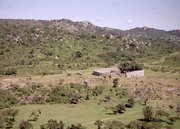Great Zimbabwe
|
|
Great-Zimbabwe-2.jpg
Great-Zimbabwe-3.jpg
Great Zimbabwe is the name given to the remains of a Southern African ancient city, located in present-day Zimbabwe which was once the centre of a vast empire known as the Munhumutapa Empire (also called Monomotapa Empire) covering the modern states of Zimbabwe (which got its name from this city) and Mozambique. The origin of the word Zimbabwe is not known, but there are two schools of thought. It could be short form for "ziimba remabwe", is a Shona (dialect: chiKaranga) term, which means "the great or big house built of stones". A second theory is that Zimbabwe is a contracted form of "dzimba woye" which means "venerated houses," a term usually reserved for chiefs' houses or graves. "Currently, Great Zimbabwe is an archeological site. The site is also modern Zimbabwe's national shrine where the Zimbabwe Bird (a national symbol of Zimbabwe) was found.
An early European explorer described it:
"Among the gold mines of the inland plains between the Limpopo and Zambezi rivers there is a fortress built of stones of marvelous size, and there appears to be no mortar joining them.... This edifice is almost surrounded by hills, upon which are others resembling it in the fashioning of stone and the absence of mortar, and one of them is a tower more than 12 fathoms [22 m] high. The natives of the country call these edifices Symbaoe, which according to their language signifies court.--Viçente Pegado, Captain, Portuguese Garrison of Sofala, 1531
Built consistently throughout the period from the years AD 400 to the 15th century, the ruins at Great Zimbabwe are the oldest and largest structures located in Sub-Saharan Africa. At its peak, estimates are that the ruins of Great Zimbabwe had as many as 18,000 inhabitants.
Built entirely of stone (those parts that survive), the ruins span 1,800 acres (7 km2) and cover a radius of 100 to 200 miles (160 to 320 km). The ruins can be broken down into three distinct architectural groups. They are known as the Hill Complex, the Valley Complex and the famous Great Enclosure. Over 300 structures have been located so far in the Great Enclosure.
Estimates are that the earliest residents of Great Zimbabwe, the Shona people, started living there around AD 400. Construction and occupation of the city continued through the 15th century. The type of stone structures found on the site give an indication of the status of the citizenry. Structures that were more elaborate were built for the kings and situated further away from the center of the city. It is thought that this was done in order to escape sleeping sickness.
What little evidence exists suggests that Great Zimbabwe also became a center for trading.
Nobody knows for sure why the site was eventually abandoned. Perhaps it was due to drought, perhaps due to disease or it simply could be that the decline in the gold trade forced the people who inhabited Great Zimbabwe to look for greener pastures.
| Contents |
European visitors
It was traders from Portugal who were the first foreigners to come to the remains of the ancient city in the early 16th century. In the 19th century, after the ruins were stumbled on by Adam Renders in 1868 and reported on by Karl Mauch in 1871, they became well known to English readers from J. Theodore Bent's season at Zimbabwe, under Rhodes' patronage. Bent, whose archaeological experience had all been in Greece and Asia Minor, stated that the ruins revealed their builders, the Phoenicians. Even after his account of the Ruined Cities of Mashonaland was published, theories as to their origin abounded, with one element in common: they could not have been built by the Bantu; they must have some Mediterranean or Biblical connection. Mauch had favored the Queen of Sheba. These speculations were dispelled by the first scientific archaeologic dig at the site, undertaken in 1905. It is now universally accepted that Great Zimbabwe was built by Africans whose descendants now live in Southern Africa, if not entirely in Zimbabwe.
A soapstone carving of a bird picked up in The Great Zimbabwe by an early European visitor was sold to Cecil Rhodes, who was intrigued by it, had copies made which he gave to friends, and even had large versions set up as gateposts at home in Cambridgeshire.
The Great Zimbabwe is a UNESCO World Heritage Site.
See also
External links
- Great Zimbabwe entry on the UNESCO World Heritage site (http://whc.unesco.org/pg.cfm?cid=31&id_site=364)
Reference
- Ndoro, Webber. "Great Zimbabwe." Scientific American, November 1997.ja:グレート・ジンバブエ遺跡
de:Great-Zimbabwe fr:Monument national du Grand Zimbabwe pl:Wielkie Zimbabwe

